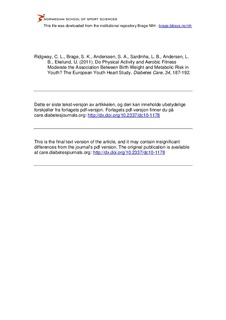| dc.contributor.author | Ridgway, Charlotte L. | |
| dc.contributor.author | Brage, Søren | |
| dc.contributor.author | Anderssen, Sigmund A. | |
| dc.contributor.author | Sardinha, Luis B. | |
| dc.contributor.author | Andersen, Lars Bo | |
| dc.contributor.author | Ekelund, Ulf | |
| dc.date.accessioned | 2012-08-28T10:07:47Z | |
| dc.date.available | 2012-08-28T10:07:47Z | |
| dc.date.issued | 2010-10-04 | |
| dc.identifier | Seksjon for idrettsmedisinske fag / Department of Sports Medicine | |
| dc.identifier.citation | Diabetes Care. 2010, 34(1), 187-192 | no_NO |
| dc.identifier.issn | 1935-5548 | |
| dc.identifier.issn | 0149-5992 | |
| dc.identifier.uri | http://hdl.handle.net/11250/170901 | |
| dc.description | I Brage finner du siste tekst-versjon av artikkelen, og den kan inneholde ubetydelige forskjeller fra forlagets pdf-versjon. Forlagets pdf-versjon finner du på care.diabetesjournals.org: http://dx.doi.org/10.2337/dc10-1178 / In Brage you'll find the final text version of the article, and it may contain insignificant differences from the journal's pdf version. The original publication is available at care.diabetesjournals.org: http://dx.doi.org/10.2337/dc10-1178 | no_NO |
| dc.description.abstract | OBJECTIVE: Lower birth weight has been associated with a greater risk of metabolic diseases. The aim of this study was examine whether physical activity and aerobic fitness may modify associations between birth weigh and metabolic risk.
RESEARCH DESIGN AND METHODS: The European Youth Heart Study is a population-based study of 9 and 15 year olds (n = 1,254). Birth weight was maternally reported. Skin fold measures were used to calculate body fat and fat mass index (FMI = fat mass [kilograms]/height²). Insulin was measured using fasting blood samples. Physical activity was measured using a hip-worn accelerometer (MTI Actigraph) for >600 min/day for ≥3 days and is expressed as "average activity" (counts per minute) and time spent in above moderate intensity activity (>2000 cpm). Aerobic fitness was assessed using a maximal cycle ergometry test (watts per kilogram fat-free mass).
RESULTS: Higher birth weight was associated with higher FMI (β = 0.49 [95% CI 0.21-0.80]; P = 0.001) and greater waist circumference (0.90 [0.32-1.47]; P < 0.001), adjusted for sex, age-group, sexual maturity, height, and socioeconomic status. Lower birth weight was associated with higher fasting insulin only after further adjustment for adolescent waist circumference and height (-0.059 [-0.107 to -0.011]; P = 0.016). There was no evidence for any modification of the associations after adjustment for physical activity or aerobic fitness.
CONCLUSIONS: The present study did not find any evidence that physical activity or aerobic fitness can moderate the associations among higher birth weight and increased fat mass and greater waist circumference or between lower birth weight and insulin resistance in healthy children and adolescents. | no_NO |
| dc.language.iso | eng | no_NO |
| dc.publisher | American Diabetes Association | no_NO |
| dc.subject | adolescent | no_NO |
| dc.subject | birth weight | no_NO |
| dc.subject | child | no_NO |
| dc.subject | female | no_NO |
| dc.subject | humans | no_NO |
| dc.subject | insulin resistance | no_NO |
| dc.subject | male | no_NO |
| dc.subject | physiology | no_NO |
| dc.subject | motor activity | no_NO |
| dc.subject | physical fitness | no_NO |
| dc.subject | waist circumference | no_NO |
| dc.title | Do physical activity and aerobic fitness moderate the association between birth weight and metabolic risk in youth?: the European youth heart study | no_NO |
| dc.type | Journal article | no_NO |
| dc.type | Peer reviewed | no_NO |
| dc.subject.nsi | VDP::Medical disciplines: 700 | no_NO |
| dc.source.pagenumber | 187-192 | no_NO |
| dc.source.volume | 34 | no_NO |
| dc.source.journal | Diabetes Care | no_NO |
| dc.source.issue | 1 | no_NO |
